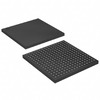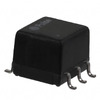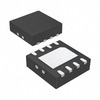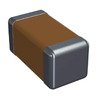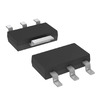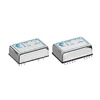AT89C52 Microcontroller: Alternatives, Features, Architecture, and Uses
Microcontrollers are the backbone of modern electronics, driving functionality in everything from everyday gadgets to industrial automation systems. The AT89C52 microcontroller stands out as a versatile and reliable option within this landscape, thanks to its powerful features and adaptability. In this article, we’ll dive into the specifics of the AT89C52, including its architecture, on-chip resources, and application potential. By understanding its capabilities and use cases, you'll gain valuable insights that can help you make informed decisions when designing and implementing embedded systems.Catalog
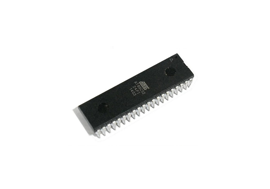
Examination of the AT89C52 Microcontroller
The AT89C52 microcontroller is characterized by its 8-bit architecture, notable for achieving efficiency alongside minimized power consumption. It integrates 8K bytes of Flash memory and 256 bytes of RAM, harnessing ATMEL's robust non-volatile storage technology. Embracing the MCS-51 instruction set, the device is equipped with 32 bidirectional I/O ports, two dedicated interrupt ports, three programmable timers, and capabilities for serial communication. By leveraging its Flash memory, development expenditures can be effectively managed through both conventional and online programming techniques.
The architecture lends itself smoothly to a broad spectrum of applications, from elementary embedded systems to intricate industrial automation frameworks. The presence of 32 I/O ports expands interfacing possibilities, offering designers enhanced latitude in crafting solutions. Furthermore, the programmable timers offer refined timing control, ideal for generating waveforms and counting events with precision.
A resilient interrupt system encourages multitasking and supports real-time applications, ensuring responsiveness in dynamic system configurations. Professionals frequently discover the serial communication features to be invaluable, streamlining the integration with other devices and optimizing data flow in networks involving multiple components. A fascinating quality of the AT89C52 is its flexibility across diverse technological stages. The microcontroller’s alignment with the MCS-51 instruction set facilitates straightforward migration and scalability, a feature principally advantageous when system upgrades or expansions are in consideration.
Replacements and Equivalents
Features of AT89C52
Operating at 5V, the AT89C52 is a versatile microcontroller with efficient functionalities for embedded systems. It's developed for industrial and consumer applications, focusing on reliability and performance crafted through engineering expertise.
Dual-Level Serial Communication
The AT89C52 supports dual-level serial communication, enhancing data transfer capabilities. This feature is suitable for smooth interaction in complex networks, allowing for seamless system integration.
Lock Bit Security
A 3-level lock bit offers protection against unauthorized access, active for safeguarding sensitive data. This security reflects a balance between accessibility and confidentiality in modern electronic systems, emphasizing the exact handling of data integrity.
Data Pointer (DPTR) Flexibility
Equipped with a Data Pointer (DPTR), the microcontroller streamlines data management, granting programmers flexibility in data manipulation. This facilitates optimized memory usage, aligning with best practices in memory management and improving execution efficiency.
Programmable I/O Lines
The 32 programmable I/O lines provide extensive interfacing options for diverse applications. Customization flexibility allows developers to design intricate systems without complex circuitry, enabling rapid prototyping and iterative design customization in practical scenarios.
Frequency and Operation Modes
With a maximum operating frequency of 24MHz, the device handles demanding tasks while offering idle and power-down modes for energy conservation. These modes enhance device lifespan and reduce power consumption, dynamic for battery-operated devices.
On-Chip Memory and Interrupt System
The microcontroller integrates 8KB of Flash program storage and 256 bytes of RAM, providing ample space for small to medium-sized applications. Its six-vector interrupt system features two priority levels, ensuring dangerous tasks receive appropriate attention in real-time applications, and highlighting its capability in delivering reliable and prompt responses.
Symbol, Footprint, and Pinout Configuration
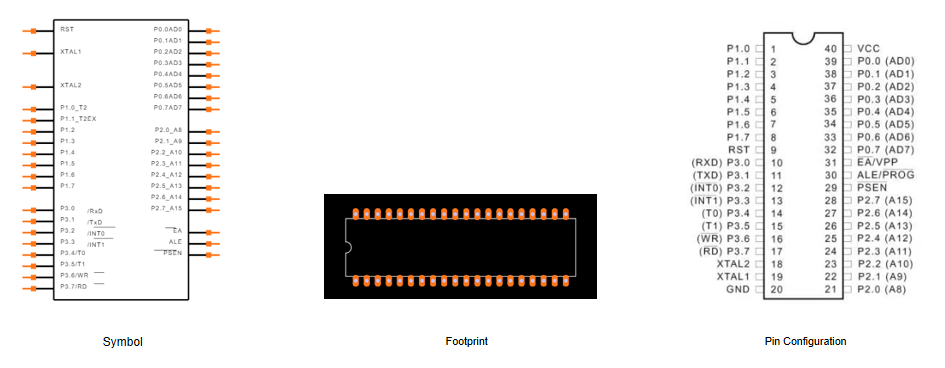
The AT89C52 microcontroller comes with 40 pins, each crafted for unique functions. Grasping the purpose of these pins enriches the experience in utilizing them within embedded systems.
General Purpose Input/Output Ports
Ports P0 to P3 function as adaptable input/output interfaces. They aid in communication with peripheral devices, fitting seamlessly into diverse applications. Skillful configuration of these ports is guided by the project's demands, drawing inspiration from industrial automation and consumer electronics scenarios.
Specialized Control Pins
The EA/VPP pin influences memory actions, determining access to internal or external memory. During programming, providing the right voltage enhances reliability. Engineers often devise plans to ensure stable voltage supply, refining performance in memory-heavy uses.
RST - Reset Functionality
The RST pin triggers a reset, enabling a fresh system start. Its role becomes substantial during software glitches or power issues. Engineers frequently use debounce circuits to foster effective resets, avoiding accidental resets that might interfere with system efficiency.
ALE/PROG - Address Latch Enable and Programming
ALE/PROG serves a dual function: managing address/data transfers and aiding programming. It secures data fidelity in high-speed tasks, making it influential in sophisticated digital systems. Utilizing effective latch methods can enhance computational precision in intricate applications.
PSEN - Program Store Enable
PSEN helps in program memory reading, allowing the microcontroller to obtain instructions—used for executing stored programs. Actual applications might include refining read cycles in code execution and nurturing efficient data handling in real-time environments.
Oscillator Connections
XTAL1 and XTAL2 link to an external oscillator, impacting clock signal production. This arrangement affects timing and speed, influencing system functionality. Employing accurate oscillators heightens timing precision, basic in applications needing synchronized tasks like telecommunications and robotics.
Capabilities of the AT89C52 Microcontroller
Storage Capabilities
The AT89C52 microcontroller adeptly handles program and data storage, major for diverse applications ranging from games to utilities. Its non-volatile memory secures data, supporting system reliability amidst both straightforward and intricate frameworks. Perceptions reveal that improving storage management can profoundly boost performance, a phenomenon especially noted in settings with limited resources.
Timing Functions
This microcontroller leverages its embedded timers to manage operations in sophisticated applications, such as smart home systems. By accurately controlling delays and timing, it delivers flawless operation and response efficiency. Implementing this timing accuracy invites more dependable automation experiences, frequently observed in modern smart devices.
Communication Features
The AT89C52 facilitates serial data interaction with various devices, enhancing remote monitoring and control systems. This capability enables streamlined data transfer across platforms, fostering greater interoperability. Experiences in integrating communication protocols emphasize the impact of selecting the appropriate interface in enhancing system stability and scalability.
Device Control
Controlling devices via GPIO ports is a core feature of the AT89C52, ensuring effective management in embedded systems. These ports allow the microcontroller to engage with a range of peripherals and sensors. Practical applications illustrate that meticulous GPIO configuration and management can suggestively boost device responsiveness and optimize energy consumption. Harnessing its complex functionalities, the AT89C52 microcontroller serves as an adaptable basis for advanced electronics, enabling you to craft inventive solutions tailored to unique desires.
Structure and Features of the AT89C52
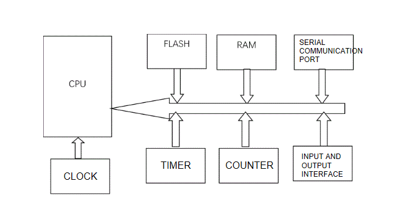
The AT89C52 is a microcontroller crafted within the MCS-51 architecture, a testament to its longstanding influence in embedded system design thanks to its sturdy framework. At its heart lies a central processing unit, complete with an arithmetic unit and controller, designed to smoothly manage task execution and control flow.
Memory and Storage
A distinguishing aspect of the AT89C52 is its 8K bytes of Flash memory. This component, being both rewritable and electronically programmable, enhances flexibility during software development and updates. Such adaptability is invaluable for applications needing regular reprogramming, facilitating iterative development cycles common in modern software engineering to meet evolving requirements.
Instruction Set Compatibility
Engineered to fully support MCS-51 instruction sets and pin functions, the AT89C52 integrates effortlessly with systems adhering to the MCS-51 standard. This smooth compatibility eases the process of migrating and upgrading legacy systems, conserving time and resources while extending operational lifespans.
Enhanced RAM Features
The inclusion of 256 bytes of RAM highlights the AT89C52's superior data handling capabilities over previous models. This advancement boosts processing efficiency, allowing for more intricate operations to be executed without substantial delay. Systems utilizing these improvements generally show heightened responsiveness and streamlined data management.
Advantages and Considerations of AT89C52
Benefits
• Offers diverse communication interfaces that enable seamless integration with various systems, enhancing operational compatibility.
• Provides extensive timer functions granting precise timing control, which aligns well with time-sensitive applications.
• Known for being cost-effective, it appeals to projects operating under financial limitations.
• Equipped with reliable built-in memory, ensuring stable and consistent performance across numerous applications.
Considerations
• Requires an external oscillator, which can complicate system design and influence overall cost.
• Lacks advanced features like an Analog-to-Digital Converter (ADC), limiting its ability to process modern analog signals, thereby necessitating additional components.
• Slower processing speed can constrain high-performance applications, prompting the need for design modifications or exploration of alternative processors for higher computational demands.
• Limited memory capacity may require external solutions for applications needing substantial data storage, posing hurdles in large-scale implementations.
Exploring the Roles of AT89C52
Elevator Systems
In elevator technology, the AT89C52 microcontroller enhances operations by coordinating tasks and issuing alerts with great precision. It interfaces with diverse sensors for seamless functionality, elevating both user experience and safety. Engineers have fine-tuned these systems to handle heavy traffic with ease, reflecting the microcontroller's dependable role in such environments.
Sensor Networks
Facilitating sensor networks, the AT89C52 offers smooth monitoring capabilities. Its adaptability supports communication across interfaces, allowing complex networks to flourish. Examples in fields like agricultural monitoring and smart homes showcase its ability to deliver cost-effective, real-time data management solutions.
Automotive Electronics
Within automotive electronics, the AT89C52 suggestively influences system management, mostly in areas such as braking systems. By integrating this microcontroller, manufacturers enhance safety and precision. Actual applications demonstrate its robust performance and adaptability, ensuring efficient operation under challenging conditions.
Communication Equipment
Supporting communication equipment, the microcontroller manages various functions with efficiency. It's effective in enabling precise data processing, as evidenced by its deployment across different industries. Its usage in both traditional and modern communication setups highlights its adaptability to technological progress.
Electronic Counters
The AT89C52 plays a major role in controlling electronic counters with accuracy. Its performance is praised in commercial and industrial settings, such as energy meters and production lines. Feedback from these sectors underscores its contribution to operational accuracy and reliability.
Embedded Systems
Widely utilized in embedded systems, the AT89C52 stands out in compact, low-power devices. Its suitability spans across diverse applications, from consumer electronics to industrial automation. Engineers have harnessed its potential to drive innovation within constraints, expanding the horizons of small-scale electronic design.
Frequently Asked Questions [FAQ]
1. What is AT89C52 microcontroller?
The AT89C52 is an 8-bit microcontroller featuring an 8K Flash memory. It aligns with industry-standard instruction sets and leverages advanced nonvolatile memory technology, delivering robust performance across diverse applications.
2. What is the purpose of the RESET pin in the AT89C52?
Engaging the RESET pin initiates a reboot of the microcontroller, prompting it to restart its program. This process helps recover from errors, supporting consistent and reliable system functionality over prolonged use.
3. What is the use of AT89C52?
This microcontroller excels in low-power environments, especially in battery-driven devices. With its 8K Flash memory and adherence to industry-standard technology, it provides stability and dependable performance in fields ranging from consumer electronics to industrial automation.
4. What is the difference between at89c51 and 89c52?
The AT89C52 stands out by offering increased RAM over the AT89C51 while retaining a similar setup. This additional memory fosters the development of more intricate applications and enhanced data management, appealing to developers seeking versatility.
5. What are the I/O ports in the AT89C52 used for?
Equipped with four I/O ports, the microcontroller is designed for seamless interaction with external devices. These ports, configurable as inputs or outputs, enable the integration of components like sensors and actuators, thus broadening the microcontroller's application spectrum in actual
scenarios.
About us
ALLELCO LIMITED
Read more
Quick inquiry
Please send an inquiry, we will respond immediately.
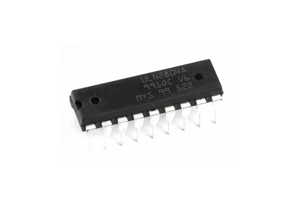
Understanding ULN2804A: Equivalent Arrays, Symbol, and Functional Overview
on September 26th
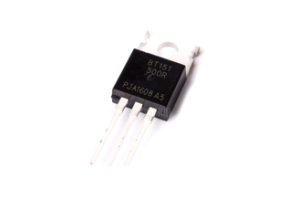
BT151 SCR Functionality: Features, Pin Configuration, and Applications
on September 26th
Popular Posts
-

What is GND in the circuit?
on January 1th 3151
-

RJ-45 Connector Guide: RJ-45 Connector Color Codes, Wiring Schemes, R-J45 Applications, RJ-45 Datasheets
on January 1th 2707
-

Understanding Power Supply Voltages in Electronics VCC, VDD, VEE, VSS, and GND
on November 16th 2291
-

Fiber Connector Types: SC Vs LC And LC Vs MTP
on January 1th 2195
-

Comparison Between DB9 and RS232
on January 1th 1815
-

What Is An LR44 Battery?
Electricity, that ubiquitous force, quietly permeates every aspect of our daily lives, from trivial gadgets to life-threatening medical equipment, it plays a silent role. However, truly grasping this energy, especially how to store and efficiently output it, is no easy task. It is against this background that this article will focus on a type of coin cell battery that may seem insignificant on the...on January 1th 1787
-

Understanding the Fundamentals:Inductance Resistance, andCapacitance
In the intricate dance of electrical engineering, a trio of fundamental elements takes center stage: inductance, resistance, and capacitance. Each bears unique traits that dictate the dynamic rhythms of electronic circuits. Here, we embark on a journey to decipher the complexities of these components, to uncover their distinct roles and practical uses within the vast electrical orchestra. Inductan...on January 1th 1737
-

CR2430 Battery Comprehensive Guide: Specifications, Applications and Comparison to CR2032 Batteries
What is CR2430 battery ?Benefits of CR2430 BatteriesNormCR2430 Battery ApplicationsCR2430 EquivalentCR2430 VS CR2032Battery CR2430 SizeWhat to look for when buying the CR2430 and equivalentsData Sheet PDFFrequently Asked Questions Batteries are the heart of small electronic devices. Among the many types available, coin cells play a crucial role, commonly found in calculators, remote controls, and ...on January 1th 1699
-

What Is RF and Why Do We Use It?
Radio Frequency (RF) technology is a key part of modern wireless communication, enabling data transmission over long distances without physical connections. This article delves into the basics of RF, explaining how electromagnetic radiation (EMR) makes RF communication possible. We will explore the principles of EMR, the creation and control of RF signals, and their wide-ranging uses. The article ...on January 1th 1695
-

Comprehensive guide to hFE in transistors
Transistors are crucial components in modern electronic devices, enabling signal amplification and control. This article delves into the knowledge surrounding hFE, including how to select a transistor's hFE value, how to find hFE, and the gain of different types of transistors. Through our exploration of hFE, we gain a deeper understanding of how transistors work and their role in electronic circu...on November 16th 1661
